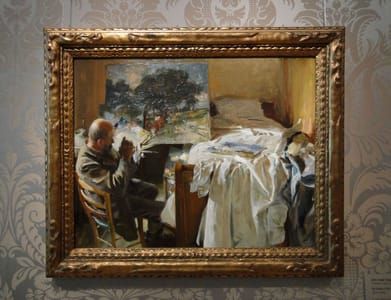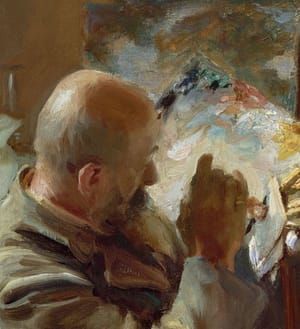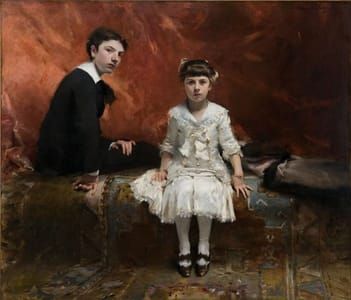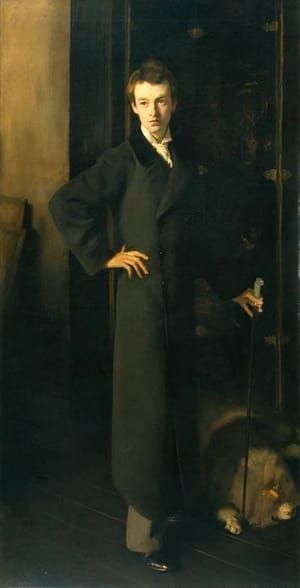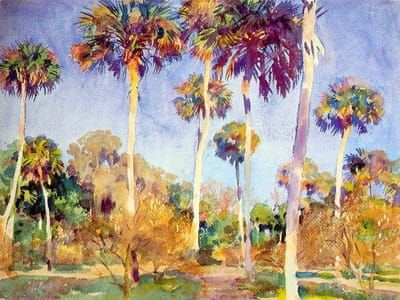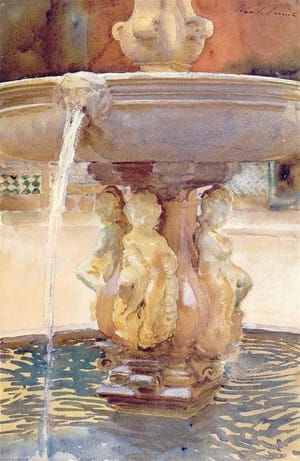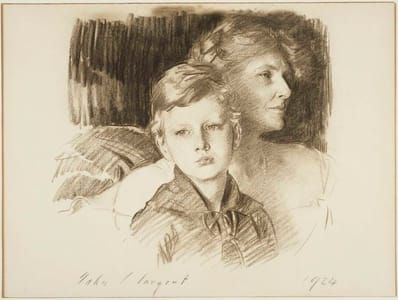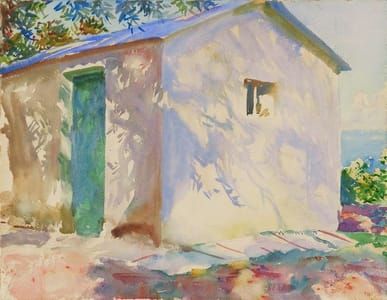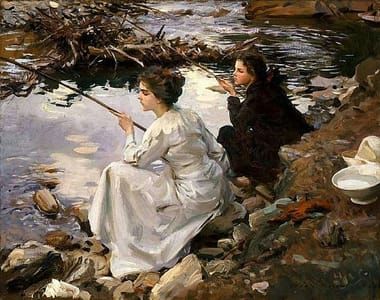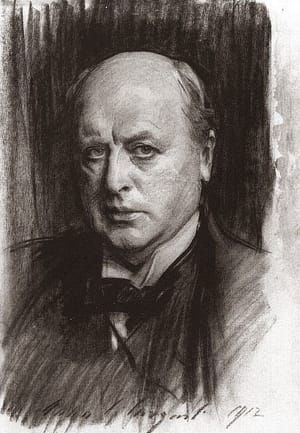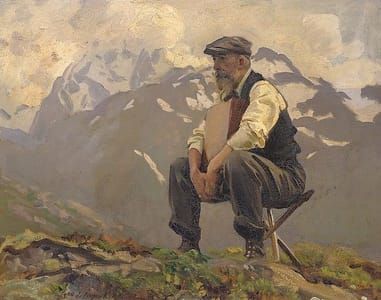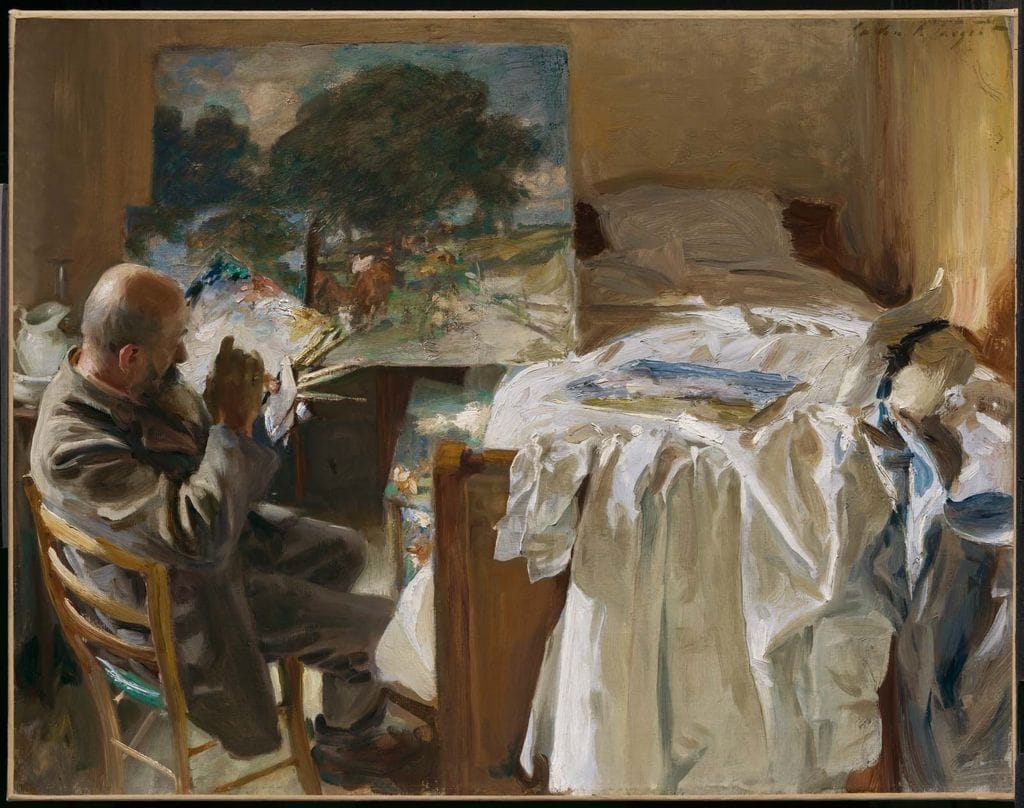

An Artist in His Studio, 1904
John Singer Sargent
An Artist in His Studio was painted in August 1904 at Purtud, while Sargent was on a summer vacation in the Italian Alps. It depicts Sargent’s friend, the Italian artist Ambrogio Raffele, deep in contemplation, working on a bucolic landscape. Raffele is using his cramped and untidy hotel room as a studio; he and his landscape painting are shifted to the left corner. Surrounded by smaller sketches presumably made outdoors, Raffele holds a palette that bears blobs of thick, bright paint, a fistful of brushes, and what may be a snapshot at which he squints as he considers his efforts. Raffele’s straw hat and shirt are tossed carelessly across the rumpled white linens of his unmade bed. The pictorial challenge of painting white on white is one Sargent particularly enjoyed; he handled it here with an extraordinary display of brilliant brushwork.
The time-honored subject of the artist at work was one of Sargent’s favorites. Beginning in the 1880s, he made many pictures of his friends painting, particularly while he was traveling or on a working holiday; he may even have sought out artists as like-minded companions for his travels. He typically showed them working outdoors; An Artist in His Studio, set in a hotel room, is an exception. The painting was created at a time when Sargent was once again showing strong interest in interior scenes. Like other such images, Sargent crafted An Artist with large, vibrant brushstrokes, impasto, and brilliant light. The bravura brushwork belies the painting’s careful creation: Sargent worked tirelessly to compose and build his paintings, adding flashing strokes only at the very end of the process to give the impression of effortlessness and spontaneity.
The painting is one of Sargent’s most cleverly composed pictures and, as a commentary on the working conditions of the peripatetic artist, one of the most revealing. This is a reprise of the picture-within-a-picture theme Sargent introduced in Claude Monet Painting by the Edge of a Wood (1885, Tate Britain, London). In that work, Monet sits in the midst of the meadow he is recreating on canvas. Here, Raffele is not painting what he sees; instead, the bucolic landscape on his easel is being manufactured indoors. The sketches scattered around the room—which may well have been produced outdoors—bear a punning similarity to his square, messy palette, as encrusted in Sargent’s painterly rendering as it no doubt was in actuality. And the crowded, makeshift studio belies the notion of the plein-air painter’s idyllic lifestyle. The picture thus suggests something of the quotidian necessities for artists seeking productive travels. Sargent called this painting both His Studio and No Nonsense, the latter title presumably a tongue-in-cheek commentary on his working holidays.
An Artist in His Studio demonstrates Sargent’s renewed commitment to producing non-commissioned work during the latter half of his career. In fact, his success as a portraitist likely helped to pave the way for the acclaim he received for the non-portrait works he often exhibited. Sargent’s independence allowed him to explore freely the artistic currents of his day, including, most importantly, Impressionism, as shown in the fluid brushwork and seemingly spontaneous nature of An Artist. The paintings Sargent produced on his travels were every bit as serious and considered as his commissioned portraits and murals, despite their picturesque and sometimes deluxe destinations. The compelling perspectives Sargent developed for them indicate their thoughtful creativity, and thus their artistic importance. In An Artist, he seems to peer over the shoulder of a friend at work. The diligent actions of Raffele, the presence of the canvas-within-a-canvas, and the lifelike palette covered with blobs of paint remind the viewer of Sargent’s presence, working like his friend at an easel propped up in the already-cramped room.
The picture was first exhibited in the winter 1905 exhibition of the New English Art Club in London. There it attracted critical attention for the exuberance of its brushwork; for the intriguing complexity of the object-littered space; and especially for the dazzling light, which silhouettes Raffele’s features against his palette and dances over the rumpled bed linens. The critic for the Art Journal praised its “glad morning light” and the reviewer for the London Times exclaimed, “Surely, never were tumbled white sheets so painted before.” When it was shown the next year in the United States, the painting was particularly admired for its subject: “it gives, without any romantic feelings whatever, the realities of the art struggle.”
The painting’s move to the United States was the result of its acquisition by the Museum of Fine Arts, Boston. An Artist in His Studio had made a favorable impression on Edward Robinson, then director of the MFA, who visited Sargent in London early in 1905 and responded immediately and enthusiastically to the picture. A fund for the purchase of contemporary art had just been established at the Museum, and Robinson recommended Sargent’s painting as the inaugural acquisition. Bought in May 1905 for $1,000, it was Sargent’s first subject picture to enter the collection of an American museum. Robinson’s confirmation of the purchase, cabled to Sargent in London, reveals his appreciation of the painting’s gentle wit: “Museum will take no nonsense from you.”
This text was adapted from Gillian Shallcross, The MFA Handbook: A Guide to the Collections of the Museum of Fine Arts, Boston [http://www.mfashop.com/780878467303.html], rev. ed. (Boston: MFA Publications, 2009), and Carol Troyen’s entry in John Singer Sargent, ed. ElaineKilmurray and Richard Ormond, exh. cat. (Princeton, N.J.: Princeton University Press, 1998).
(http://www.mfa.org/collections/object/an-artist-in-his-studio-31260)
22 x 28 in
Uploaded on Oct 27, 2017 by Suzan Hamer
John Singer Sargent
artistArthur
Wait what?


